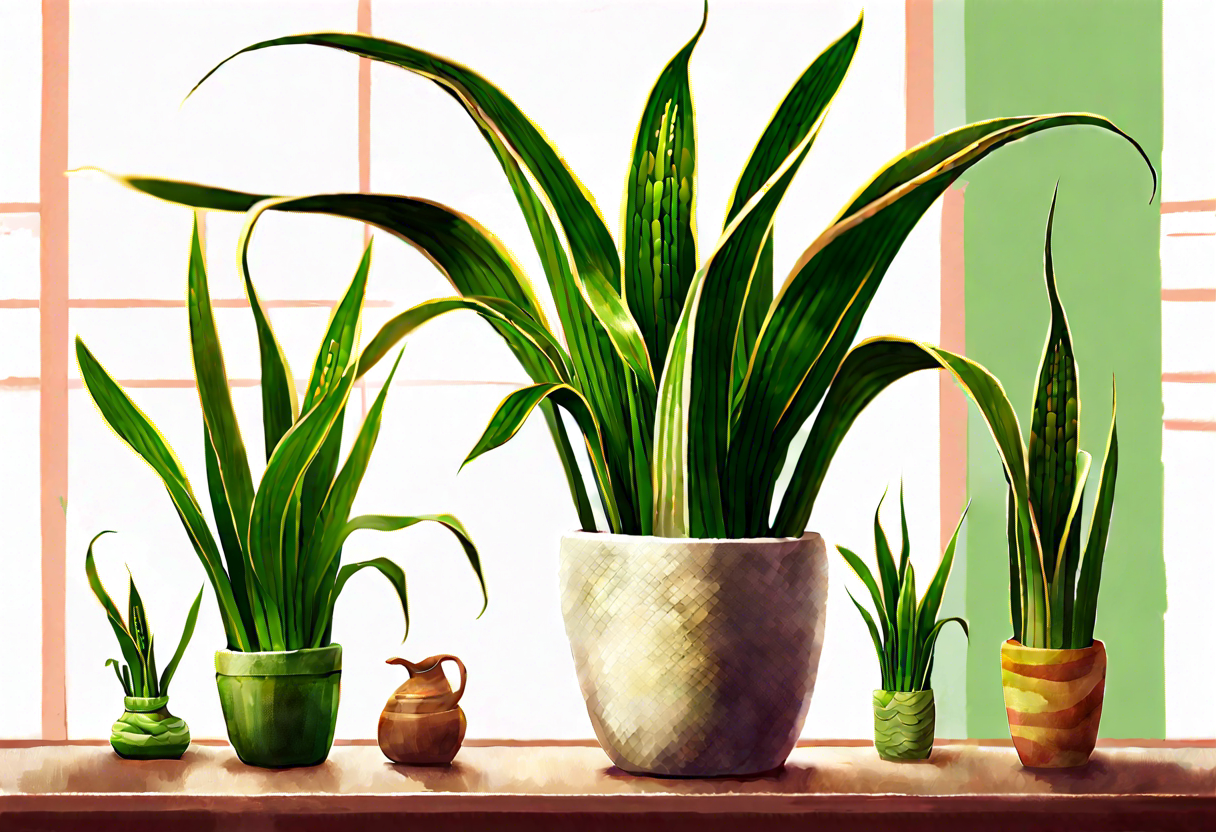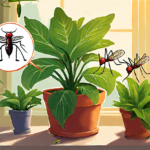Watering requirements for indoor snake plants
Snake plants, also known as Sansevieria, are popular indoor plants due to their low maintenance requirements and air-purifying qualities. Proper watering is essential for the overall health and vitality of snake plants. In this article, we will discuss the watering needs of snake plants and provide some useful tips to ensure their well-being.
Snake plants have succulent leaves that store water, allowing them to tolerate periods of drought. As a result, they are more resilient to underwatering compared to overwatering. Overwatering is a common mistake that can lead to root rot and other issues.
To care for your snake plant, it is important to adhere to a watering schedule that allows the soil to dry out between waterings. Ideally, you should water your snake plant once every 2-3 weeks during the growing season. However, this frequency may vary depending on factors such as the humidity levels in your home and the size of the pot.
Before watering your snake plant, check the moisture level of the soil by inserting your finger about an inch deep. If the soil feels dry, it is time to water. Use room temperature water and apply it directly to the soil, avoiding wetting the leaves. Ensure that the water drains out of the pot completely to prevent waterlogging.
During the winter months or when the snake plant enters a dormant period, reduce the frequency of watering. This is because snake plants require less water during their resting phase. Monitor the soil moisture and adjust the watering schedule accordingly.
In addition to the frequency of watering, it is important to consider the type of pot and soil used for your snake plant. Choose a well-draining pot with drainage holes to prevent water from accumulating at the bottom. Using a well-draining soil mix that consists of a combination of potting soil, sand, and perlite will further enhance drainage.
Remember, it is better to underwater your snake plant than to overwater it. Over time, you will become familiar with your plant’s water requirements and adjust your watering routine accordingly.
Maintaining the proper watering routine is crucial for the health and longevity of indoor snake plants. By allowing the soil to dry out between waterings and using well-draining pots and soil, you can ensure that your snake plant thrives in its indoor environment. Remember to monitor the moisture levels regularly and adjust your watering schedule accordingly. With a little care and attention, your snake plant will continue to enhance your indoor space for years to come.
Light and Temperature Needs of Snake Plants
Snake plants, also known as Sansevieria, are popular houseplants known for their sleek and upright leaves. These plants are relatively easy to care for, but understanding their light and temperature preferences is crucial for their well-being. In this article, we will explore the light and temperature needs of snake plants and provide you with practical tips on how to ensure they thrive indoors.
Light Requirements:
Snake plants are versatile when it comes to light conditions, making them suitable for various areas within your home. While they can tolerate low light conditions, they prefer bright, indirect light for optimal growth. Placing your snake plant near a north or east-facing window is ideal, as it allows filtered light to reach the plant without the risk of direct sun exposure, which can damage the leaves.
If you have a south or west-facing window, it’s best to keep the snake plant a few feet away from the window or use sheer curtains to filter the intensity of the sunlight. Too much direct sunlight can scorch the leaves, causing them to turn yellow or brown.
Temperature Requirements:
Snake plants are resilient and can tolerate a wide range of temperatures. Ideally, they thrive in temperatures between 70-90°F (21-32°C) during the day and 60-70°F (15-21°C) at night. However, snake plants can withstand temperatures as low as 50°F (10°C) and as high as 85°F (29°C) for short periods.
It’s important to avoid exposing snake plants to extreme temperature fluctuations, such as placing them near drafts, vents, or air conditioning units. Sudden temperature changes can lead to stress and negatively impact their growth.
Additional Tips:
- Rotate your snake plant every few months to ensure even exposure to light. This will prevent the leaves from leaning towards the light source.
- If your snake plant is not receiving enough light, you may notice it stretching or leaning. In such cases, consider providing supplemental artificial light to support its growth.
- Avoid placing snake plants in excessively dark corners or rooms, as this can lead to weak, floppy leaves.
- During the winter months, it’s best to move snake plants away from drafty windows or cold areas to prevent cold damage.
By providing the right balance of light and maintaining a suitable temperature range, you can ensure that your indoor snake plant remains healthy and vibrant. Incorporate these tips into your plant care routine, and you’ll enjoy the beauty of these elegant plants for years to come.
Choosing the Right Soil for Snake Plants
Snake plants, also known as Sansevieria, are popular indoor plants due to their low maintenance and ability to tolerate a variety of growing conditions. One key factor in their successful growth is choosing the right soil. The right soil composition provides the necessary nutrients, drainage, and aeration for the snake plant’s roots to thrive. In this article, we will discuss the ideal soil requirements for your indoor snake plant.
When it comes to the soil for snake plants, it’s important to prioritize good drainage. Snake plants are susceptible to root rot if the soil remains wet for extended periods. To achieve optimal drainage, select a well-draining potting mix. A mix consisting of equal parts of peat moss, perlite, and coarse sand can create an ideal medium. This combination allows excess water to drain away from the roots, preventing waterlogging and potential rotting issues.
Another important aspect to consider is the pH level of the soil. Snake plants prefer slightly acidic to neutral soil with a pH range between 6 and 7. You can measure the pH of your soil using a pH testing kit available at most garden centers. If the pH of your soil is outside the optimal range, you can adjust it by incorporating soil amendments. Adding peat moss or compost can help lower the pH, making it more suitable for your snake plant.
In terms of fertility, snake plants are not heavy feeders and can thrive in relatively low-nutrient soil. Avoid using overly rich or heavily fertilized soil, as it can lead to excessive foliage growth with weaker roots. Instead, opt for a well-balanced potting mix that provides sufficient nutrients without overstimulating growth. Alternatively, you can apply a balanced liquid fertilizer diluted to half strength once or twice a year during the plant’s active growing season.
It’s also worth noting that snake plants do not appreciate compacted soil. Compact soil can hinder the plant’s root development and impede nutrient absorption. Therefore, it’s crucial to ensure that the soil is loose and well-aerated. One way to improve soil structure is by incorporating organic matter such as compost or coco coir. These organic materials can enhance moisture retention, improve drainage, and promote beneficial microbial activity in the soil.
The right soil for indoor snake plants should prioritize good drainage, a slightly acidic to neutral pH, and a well-balanced nutrient content. A well-draining potting mix composed of peat moss, perlite, and coarse sand creates an ideal growing medium. Avoid overly rich or compacted soil, and instead focus on maintaining a loose and well-aerated soil structure. By providing the proper soil conditions, you can ensure the health and vigorous growth of your snake plant indoors.
Pruning and Propagating Snake Plants
When it comes to caring for snake plants, pruning and propagating are important tasks that can help maintain the health and vitality of your indoor plant. Pruning helps remove any dead or damaged leaves, while propagation allows you to create new plants from existing ones. In this article, we will discuss the step-by-step process of pruning and propagating snake plants.
Pruning Snake Plants
Pruning snake plants is a simple task that can be done to keep the plant looking neat and tidy. Here’s a step-by-step guide on how to prune your indoor snake plant:
-
Identify the leaves to be pruned: Inspect your snake plant and identify any discolored, yellowing, or damaged leaves that need to be pruned. These leaves may be detracting from the overall appearance of the plant or could be a sign of disease or pest infestation.
-
Prepare the tools: Ensure you have a clean pair of pruning shears or scissors. It’s essential to use sharp and sterile tools to prevent the spread of diseases.
-
Trim the leaves: Position the pruning tool close to the base of the leaf, where it emerges from the soil, and make a clean cut. Remove all the identified leaves one by one, taking care not to damage the healthy ones.
-
Dispose of the pruned leaves: Dispose of the pruned leaves properly. Do not compost them, as some diseases or pests may remain on the discarded leaves.
Propagating Snake Plants
Propagating snake plants is an excellent way to expand your plant collection or share them with friends and family. Here’s a step-by-step guide on how to propagate snake plants:
-
Choose a healthy mother plant: Select a mature snake plant with several healthy leaves. This will ensure that the propagated plant starts off on the right foot.
-
Prepare the tools and materials: Get a clean and sharp knife or shears, a small pot or container filled with well-draining soil, and some water.
-
Remove a healthy leaf: Identify a healthy leaf from the mother plant and gently remove it by cutting it close to the soil line. Avoid damaging the leaf or the mother plant.
-
Prepare the leaf cutting: Let the leaf cutting dry for a few days until the cut end forms a callus. This will help prevent rotting when planting.
-
Plant the leaf cutting: Place the calloused end of the leaf cutting into the soil, burying it about an inch deep. Ensure that the leaf remains partially above the soil surface.
-
Provide proper care: Place the planted leaf cutting in a warm, well-lit location with indirect sunlight. Water the cutting lightly, keeping the soil slightly moist but not overly wet. Roots should start to develop in a few weeks.
-
Nurture the new plant: As the new plant grows, continue to provide it with proper care, including regular watering and occasional fertilization. Over time, new shoots will emerge from the base of the leaf cutting, forming a new snake plant.
By regularly pruning and propagating your snake plants, you can maintain their health and promote their growth. Remember to enjoy the process and the beauty of these versatile indoor plants. Happy gardening!
Common Pests and Diseases Affecting Snake Plants
Snake plants, also known as Sansevieria, are popular indoor plants due to their hardy nature and air-purifying qualities. However, even these resilient plants can fall prey to various pests and diseases if not properly cared for. In this article, we will explore some of the common issues that can affect snake plants and provide tips on how to prevent and treat them.
One of the most common pests that can infest snake plants is spider mites. These tiny creatures are often found on the undersides of leaves and can cause significant damage if left unchecked. To prevent spider mite infestations, regularly inspect your snake plant for any signs of webbing or small dots on the leaves. If detected, immediately isolate the affected plant and gently wipe down the leaves with a damp cloth. For severe infestations, you may need to use an insecticidal soap or neem oil spray to eliminate the pests.
Another common pest that can trouble snake plants is mealybugs. These small, white insects often gather in clusters around the base of the leaves and stems, sucking sap and leaving behind a sticky residue. To prevent mealybug infestations, regularly inspect your plant for any signs of these pests. If found, use a cotton swab soaked in rubbing alcohol to dab and remove the bugs. For larger infestations, you may need to apply a systemic insecticide or use a solution of dish soap and water to eliminate them.
Snake plants are generally not susceptible to many diseases, but overwatering and poor drainage can lead to root rot. Root rot is characterized by wilting, yellowing leaves and a foul smell emanating from the soil. To prevent root rot, ensure that your snake plant is potted in well-draining soil and that the pot has drainage holes. Allow the soil to dry out between waterings, and never let the plant sit in standing water. If root rot is detected, remove the affected plant from its pot, trim away any rotting roots, and repot in fresh, well-draining soil.
Leaf blight is another condition that can affect snake plants, causing brown, mushy spots on the leaves. Leaf blight is often caused by overwatering or excessively humid conditions. To prevent leaf blight, make sure to water your snake plant sparingly and avoid misting the leaves. If leaf blight occurs, remove the affected leaves and adjust the watering routine to prevent further damage.
While snake plants are generally low-maintenance, they are not invincible to pests and diseases. Regular inspections, proper watering, and good hygiene practices are crucial in ensuring the health and longevity of your indoor snake plants. By following these tips, you can keep your snake plants thriving and free from common pests and diseases.
Conclusion
Snake plants are a popular choice for indoor plant enthusiasts due to their low maintenance and ability to thrive in diverse environments. However, to ensure the health and longevity of your snake plant, it is essential to provide proper care and attention. By understanding the watering requirements, light and temperature needs, soil selection, pruning techniques, and protection against pests and diseases, you can create an ideal indoor environment for your snake plant.
When it comes to watering indoor snake plants, it is crucial to strike a balance. These plants prefer slightly dry soil, so overwatering should be avoided. It is recommended to water the snake plant thoroughly but infrequently, allowing the soil to dry out between waterings. This prevents issues such as root rot and fungal diseases, which can be detrimental to the plant’s health.
In terms of light and temperature, snake plants are known for their adaptability. They can thrive in a wide range of lighting conditions, from low light to bright, indirect light. However, direct sunlight should be avoided as it can cause sunburn and damage the leaves. As for temperature, snake plants prefer temperatures between 60-85°F (15-29°C), which is typically comfortable for most indoor environments.
Choosing the right soil is essential for the well-being of indoor snake plants. They require well-draining soil to prevent waterlogging, which can lead to root rot. A soil mix that consists of equal parts potting soil, perlite or sand, and peat moss or coco coir will provide the necessary aeration and drainage while retaining some moisture.
Pruning and propagating snake plants can help maintain their shape and encourage new growth. Pruning involves removing dead or damaged leaves, as well as any long, leggy stems. This promotes a more compact and aesthetically pleasing appearance. Propagation is a great way to expand your snake plant collection or give them as gifts. It can be done by dividing the plant or rooting leaf cuttings in water or moist soil.
Unfortunately, snake plants are not immune to pests and diseases. Common pests that can infest indoor snake plants include spider mites, mealybugs, and scale insects. Regularly inspecting the leaves and stems for any signs of infestation such as webbing, sticky residue, or abnormal growth can help catch these pests early. In terms of diseases, root rot and fungal infections can occur if the plant is overwatered or exposed to excessively moist conditions. Proper watering practices and maintaining good airflow around the plant can prevent these issues.
Maintaining the health and beauty of your indoor snake plant requires attention to various aspects of care. Understanding their watering needs, providing suitable light and temperature, choosing the right soil mix, employing appropriate pruning and propagation techniques, and safeguarding against common pests and diseases will contribute to a thriving indoor snake plant. By following these guidelines, you can enjoy the lush and vibrant presence of snake plants in your indoor spaces for years to come.


